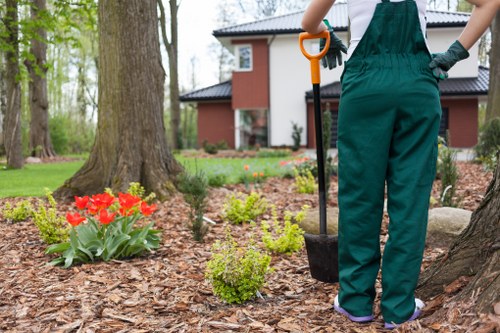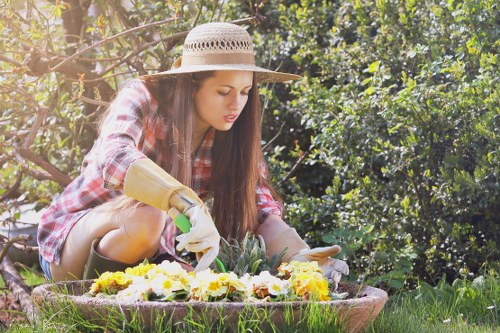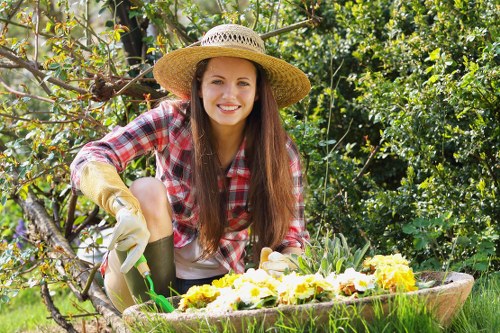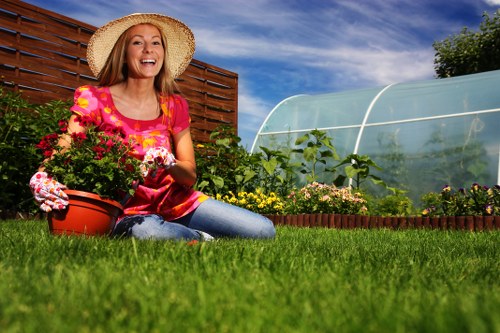Transforming Outdoor Spaces: The Art of Landscaping in Landscape Gardening

Introduction to Landscaping
Landscaping plays a crucial role in enhancing the beauty and functionality of outdoor spaces. Whether you're a homeowner looking to beautify your garden or a professional gardener aiming to create stunning landscapes, understanding the fundamentals of landscaping is essential.
Landscape gardening involves the strategic arrangement of plants, structures, and outdoor elements to create aesthetically pleasing and sustainable environments. This art form not only adds value to properties but also promotes a sense of tranquility and connection with nature.
In this article, we'll delve into the various aspects of landscaping in landscape gardening, providing insights and tips to help both novice and experienced gardeners achieve remarkable results.

Planning Your Landscape
Assessing the Space
Before embarking on any landscaping project, it's vital to assess the space you intend to transform. Consider factors such as the size of the area, existing structures, soil quality, and climate conditions. Understanding these elements will help you make informed decisions about plant selection and design layout.
Take measurements and create a scaled drawing of your garden space. This will serve as a blueprint, allowing you to visualize the placement of various elements and ensure a balanced design.
Additionally, identify any challenges, such as poor drainage or limited sunlight, and plan accordingly to mitigate these issues.
Defining Your Goals
Determine what you want to achieve with your landscaping project. Are you aiming for a serene retreat, a vibrant entertainment area, or a functional space for gardening? Defining clear goals will guide your design choices and help prioritize features that align with your vision.
- Aesthetic Appeal: Focus on creating visual harmony through color schemes, plant arrangements, and structural elements.
- Functionality: Ensure that the space meets practical needs, such as seating areas, pathways, and gardening zones.
- Sustainability: Incorporate eco-friendly practices like using native plants and efficient irrigation systems.

Selecting the Right Plants
Choosing Native Plants
Native plants are well-suited to the local climate and soil conditions, making them a sustainable choice for landscaping. They require less maintenance, are more resistant to pests and diseases, and provide essential habitat for local wildlife.
Research the native flora in your region and select a variety of plants that offer different textures, colors, and seasonal interest. This diversity will enhance the visual appeal of your garden throughout the year.
Balancing Plant Types
A successful landscape garden incorporates a mix of trees, shrubs, perennials, and annuals. This balance ensures a dynamic and layered appearance, adding depth and dimension to your outdoor space.
- Trees: Provide structure and shade, serving as focal points in the landscape.
- Shrubs: Add fullness and can be used to create borders or hedges.
- Perennials: Offer long-lasting blooms and repeat interest each season.
- Annuals: Introduce vibrant colors and can be changed regularly for variety.
By thoughtfully selecting and arranging plant types, you can create a harmonious and inviting garden environment.
Considering Growth Habits
Understand the growth habits of each plant, including their mature size, spread, and height. This knowledge prevents overcrowding and ensures that plants have sufficient space to thrive.
Additionally, consider the light and water requirements of each species to place them in appropriate locations within your garden.

Incorporating Hardscaping Elements
Pathways and Walkways
Pathways provide structure and guide movement through the garden, enhancing both accessibility and visual appeal. Materials such as gravel, paving stones, brick, or wood can be used to create paths that complement your landscape design.
When designing pathways, consider their placement in relation to plant beds, seating areas, and other garden features to ensure a cohesive flow.
Water Features
Water features like ponds, fountains, and waterfalls add a soothing auditory element and can become focal points in your garden. They create a sense of tranquility and attract beneficial wildlife such as birds and butterflies.
- Ponds: Ideal for larger gardens, ponds can be home to fish and aquatic plants.
- Fountains: Offer a central water feature that requires relatively low maintenance.
- Waterfalls: Add movement and a natural feel to your landscape.
Stonework and Patios
Stonework, including patios and retaining walls, provides functionality and aesthetic value. Patios offer space for outdoor gatherings, while retaining walls help manage slopes and prevent erosion.
Select materials that complement the overall design and ensure durability to withstand the elements.

Maintaining Your Landscape
Regular Care and Upkeep
Maintaining a beautiful landscape requires consistent care. Regular tasks include watering, pruning, weeding, and monitoring for pests and diseases.
Implement a maintenance schedule to keep your garden in optimal condition. This proactive approach helps prevent issues from escalating and ensures that your landscape remains vibrant and healthy.
Seasonal Adjustments
Each season presents unique challenges and opportunities for your garden. Adjust your maintenance routine to address seasonal changes, such as protecting plants during winter or preparing beds for spring planting.
- Spring: Plant new flowers, fertilize soil, and prune deciduous trees.
- Summer: Focus on watering, mulching, and controlling pests.
- Autumn: Clean up fallen leaves, plant bulbs for spring, and prepare perennials for winter.
- Winter: Protect sensitive plants and plan for the upcoming growing season.
Sustainable Practices
Incorporate sustainable practices to promote environmental stewardship and reduce your garden's ecological footprint. Utilize rainwater harvesting, composting, and integrated pest management to create a resilient and eco-friendly landscape.
Enhancing Aesthetics with Lighting
Outdoor lighting not only extends the usability of your garden into the evening but also accentuates key features, adding depth and ambiance. Consider a mix of ambient, task, and accent lighting to create a balanced and inviting atmosphere.
Solar-powered lights are an eco-friendly option that reduces energy consumption while providing effective illumination. Strategically place lights along pathways, near water features, and around seating areas to highlight their beauty and ensure safety.
Experiment with different lighting styles, such as string lights, lanterns, and spotlights, to achieve the desired mood and functionality.
Choosing the Right Fixtures
Select fixtures that complement your landscape design and withstand outdoor conditions. Durable materials like stainless steel, aluminum, and weather-resistant plastics are ideal for longevity.
Energy Efficiency
Opt for energy-efficient lighting solutions, such as LED bulbs, which consume less power and have a longer lifespan compared to traditional lighting options.
Creating Functional Zones
Dividing your garden into functional zones enhances both its usability and aesthetic appeal. Common zones include dining areas, lounging spaces, play areas, and vegetable gardens.
Use elements like pergolas, hedges, or changes in elevation to define each zone, creating a sense of order and purpose within your landscape.
- Dining Area: Incorporate a table, chairs, and shade structures for outdoor meals and gatherings.
- Lounging Space: Add comfortable seating, such as benches or outdoor sofas, for relaxation.
- Play Area: Designate a safe space for children with appropriate play equipment and soft ground coverings.
- Vegetable Garden: Allocate space for growing herbs, vegetables, and fruits, utilizing raised beds or dedicated plots.
Pathway Integration
Integrate pathways between zones to facilitate easy movement and enhance the overall flow of the garden. Curved paths add a natural feel, while straight paths provide a more structured look.
Sustainable Landscaping Practices
Embracing sustainable landscaping practices benefits both the environment and your garden's health. By minimizing resource usage and promoting ecological balance, you create a resilient and thriving outdoor space.
Water Conservation
Implement water-saving techniques such as mulch application, drip irrigation systems, and selecting drought-tolerant plants. These measures reduce water wastage and ensure that your garden remains hydrated efficiently.
Soil Health
Healthy soil is the foundation of a successful landscape garden. Regularly amend the soil with organic matter like compost to improve fertility, structure, and moisture retention.
- Composting: Recycle garden waste and kitchen scraps to create nutrient-rich compost.
- Mulching: Apply mulch to suppress weeds, retain moisture, and regulate soil temperature.
- Cover Crops: Plant cover crops during off-seasons to prevent soil erosion and enhance soil health.
Integrated Pest Management
Adopt an integrated approach to pest management by using biological controls, such as beneficial insects, and practicing cultural methods like crop rotation. This reduces reliance on chemical pesticides and promotes a balanced ecosystem.
Innovative Landscaping Trends
Stay inspired by exploring the latest landscaping trends that can elevate your landscape garden. Innovative designs and modern techniques offer fresh ways to enhance your outdoor space.
Vertical Gardens
Vertical gardens utilize walls, trellises, and vertical structures to grow plants, maximizing space and adding a striking visual element. They are particularly beneficial for small gardens or urban settings.
Edible Landscaping
Integrate edible plants into your landscape design, combining beauty with functionality. Fruit trees, vegetable beds, and herb gardens contribute to both aesthetics and sustainability.
- Fruit Trees: Offer shade and delicious produce.
- Herb Borders: Add fragrance and fresh ingredients for cooking.
- Vegetable Rows: Provide a practical and attractive food source.
Smart Landscaping
Incorporate technology into your landscaping with features like automated irrigation systems, smart lighting, and weather-responsive installations. These innovations enhance convenience and efficiency in garden maintenance.
Conclusion
Landscaping in landscape gardening is a harmonious blend of art and science, requiring thoughtful planning, creativity, and ongoing maintenance. By understanding the key elements and embracing sustainable practices, you can create a beautiful and functional outdoor space that reflects your personal style and enhances your connection with nature.
Whether you're transforming a small backyard or designing an expansive garden, the principles outlined in this article will guide you in achieving a stunning and resilient landscape. Remember, the success of your garden lies in both its aesthetic appeal and its sustainable foundation.
Take the Next Step
Ready to transform your outdoor space? Contact us today to book your landscaping service and start creating the garden of your dreams.



